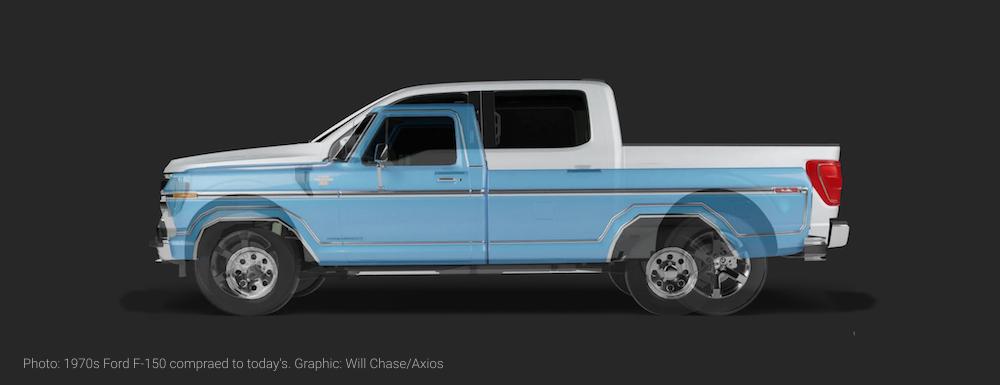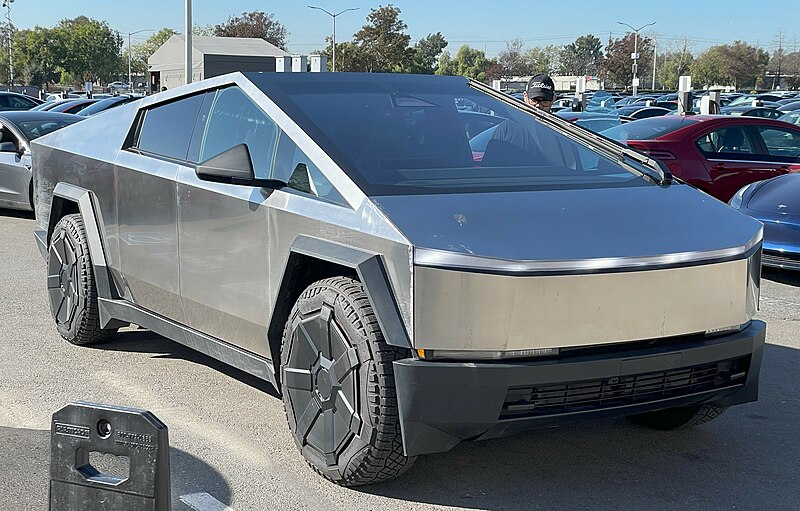Shiny Stainless Reflections
On December 8th of this year (2023), a week or so after the release of the Tesla Cybertruck, Road & Track magazine’s Victoria Scott wrote a wonderful short essay that included this:
“…our vehicles reflect (widespread cultural) anxieties. More than half of vehicles sold today in America are trucks and SUVs; this fueled a new all-time high for the average weight of a new passenger vehicle in 2022, which hit a staggering 4329 pounds. Pickup buyers, more frequently than other types of vehicle owners, say they enjoy their trucks because they are “powerful” and “rugged”. Most new vehicle buyers rate vehicle safety as a top priority in their purchases, and larger vehicles are indeed safer for occupants than small ones (although they have vastly more negative externalities, such as tire particulates and dead pedestrians).”
Humpf. I get it. She’s 1000% correct. It’s easy to see, literally everywhere. One would have to be heavily sedated or sleeping like Rip Van Winkle to miss this, and importantly it’s not wonderful news for everyday street motorcycling riders here in America.
While some places in Europe have recently noted increases in lightweight and mid-sized motorcycle and scooter sales, here with few exceptions (dual-sport and ADV bikes), sales of most kinds of motorcycles have been flat or declining for several years. Editor Scott’s wonderful short R&T essay helped me better absorb the zeitgeist surrounding motorcycling in America. Her full essay is here, and it’s not behind a paywall. And, for a slightly deeper dive into the increased popularity of light trucks and SUVs, this is another excellent essay.
Adding anything to this without mentioning political aspects probably isn’t possible. For example, on March 4th, 1933, President Franklin Roosevelt in his inaugural address to the nation famously said: “We have nothing to fear but fear itself.” Those were dark times as most Americans struggled through the depths of the Great Depression. Consciously and unconsciously motorcycle riders confront a diverse range of fears directly and in real time. Motorcycling teaches riders the ‘nothing-to-fear-but-fear-itself’ lesson in so powerful a way riding is not only good for individual riders, but is also good for society. Is there independently verifiable evidence for this? No. Can I offer documented historical support for such a claim? No. Only my years of personal riding experiences, which for better or worse, helped form those beliefs.
Riding, even for short distances, and regardless of the model, style, or age of the machine, always helps me feel better and better understand and appreciate more completely and gratefully my place in the universe. My body naturally craves the neural endorphins released by all kinesthetic activities, from walking to skating to skiing to sailing to riding. Among these, motorcycle riding is the most easily incorporated into routine daily life. I can’t sail, ski, skate or surf to work and for errand-running.
Do I admire the new Cybertruck? Yes, without reservation. It’s an amazing machine from an amazing company led by an amazing fellow. Would I want one as a gift? Nope, at least for any purpose other than quickly selling it to provide money for other things, because whenever I try to imagine myself using one, all I can think of is the unwanted attention I’d receive. For the record, whenever I’m motorcycling, other than the conspicutity aspect, I don’t appreciate whatever non-traffic tactical awareness’s may be directed toward me by drivers of four-wheeled vehicles. But there’s a difference. For the moment using Cybertruck evidences one’s strength, wealth, bad-assedness and coolness – and to most non-riding people any motorcycle, no matter how technically or artistically interesting, evidences its rider to have a bit of immaturity mixed with an unwise disregard for personal safety.
We are all evolutionarily pre-disposed to admire, celebrate and follow heroic, strong, confident leader-types. Not individuals who may be compensating for some kind of unknown missing psychological piece. Unfortunately, this is probably how motorcycle riders in general are being understood by the largest majority of car, SUV, and light truck drivers. It is a profound lack of understanding.
Regardless of how many are ever sold, the innovative Tesla machine is a great halo-vehicle for that business. Way back in 1953 the Corvette sports car provided a similar halo-effect for Chevrolet. Just as its creators had hoped, the two seat sports car drew more driver-consumers to the brand, who then bought sedans and station wagons. In 1964½ the fresh Ford Mustang did this same halo-thing for Ford. All three machines captured the zeitgeist at the time of their introduction perfectly, and cast a bright halo around the brands they represented.
For Chevy, back in 53, most Americans were enjoying rising postwar affluence and the beginnings of the interstate highway system. New roads were opening everywhere and all of them seemed to lead toward exciting experiences. For Ford, the 64½ zeitgeist involved new levels and kinds of self-fulfillment, liberation, a sexual revolution, and the seemingly unlimited potentials of an approaching aquarian age. For Tesla in 2023, the dominant mood is everone’s broadly underlying fear that everything is falling apart, so a Cybertruck could be your aspirational personal tank: a powerful sci-fi car for safely driving through a presumed oncoming apocalypse. Today we apparently have everything to fear.
All technologies exist to improve our lives and increase our personal odds for longer-term survival. They do this partly by protecting and insulating us from the unknown difficulties, discomforts and uncertainties surrounding us. But there’s a Catch. The less we know about the people and situations around us from shared direct first-hand experiences, the greater is the potential is for us to become more and more afraid. Cars, light trucks and SUVs, as wonderfully useful and enjoyable as they are are, provide an everyday example of this simple truth. For multiple reasons, compared to conventional light trucks and SUV’s, the Cybertruck dials this up to eleven.
Side note (now a word from our sponsor…): The various digital technologies which so recently have given us the internet, social media, email, online gaming, and many other powerful and useful tools, do this as well. Despite the increased ease of connecting and working with others (by phone, text, email, etc) these technologies provide, we are all increasingly being isolated each other and from nature.. Most technologies come with this same double-edged blade. Enclosed motor vehicles and digital simulacrums inescapably dissolve some of the glues the traditional less-sheltering and less-siloing human experiences provide. Those experiences nourish all of our social contract protocols, and those in turn are foundational for broadly civil behavior, and for advancing civilization-in-general.
Back to the Cybertruck and motorcycles. Most riders are well aware the average age of American motorcyclists has been increasing in a kind of weird synchrony with the rising popularity of well-sealed, infotainment-enhanced, slab-sided pickups and SUV’s. These parallel yet intersecting deltas not only make it more difficult for those working at providing motorcycles and related goods and services for riders, they also make a few things worse for everyone. Riders and non-riders alike.
A Cybertruck teaches its owner to be ever more fearful on each drive because it is so superior at isolating its driver and passengers from the rest of us, and from nature. No motorcycle does that, despite many riders choosing gear seemingly stylized to be a means of amplifiying this result (Example: a flat black helmet with a de-humanizing mirrored face shield, etc). Every motorcycle teaches its rider to be a bit less afraid on every ride. This is especially true if one figures out how to ride more or less safely and comfortably through lousy weather. In most circumstances, I selfishly prefer riding my motorcycle and what it does for me: biologically, neurologically, and philosophically.
Regardless of the thickness of your wallet, the choice is yours.


--Mr. Subjective
Text and email are convenient, but often a phone call is more personal and enjoyable. Or better still, an in - person visit?
Nice!
There have been a lot of studies done on oversized truck and SUV owners and not much of it points to positive personality attributes. This is one of my favorite summaries: https://www.youtube.com/watch?v=jN7mSXMruEo. As a bicyclist and motorcyclist, I can provide lots of anecdotal "evidence" of how clueless and dangerous these characters are. You just have to assume anyone who "needs" that kind of validation is an idiot and keep an appropriate distance.
Well, maybe. It's been a few years since I ran down the numbers, but the last time I did, they showed a trend that fatalities/million miles did decrease as weight increased WITHIN A VEHICLE CLASS. That is, a heavier PASSENGER CAR was safer than a lighter PASSENGER CAR. But there were enormous differences in safety between vehicle classes. At any given vehicle weight, SUVs were more dangerous than passenger cars (that is, a 3000-pound SUV is more dangerous than a 3000-pound sedan), and pickup trucks were more dangerous than SUVs. Makes sense when you think about it. SUVs and trucks have more weight devoted to driveline components that don't contribute to crash protection. They are taller and more prone to sway or even roll over in sharp cornering. Pickups in particular have horrible weight distribution, which also leads to unstable handling. And, of course, the feeling of invulnerability that comes from driving a tank (backed up by multi-million-dollar marketing campaigns) encourages irresponsible driving.
One of my pet peeves is being stuck behind a tall, wide pickup truck on a twisty road where passing is not an option. These things almost invariably come to a near stop for corners. I suspect this is because such tall vehicles, despite their expensive "stability control" systems, sway enough to make the drivers overly nervous.
The graphic is enlightening. I want the '70s-vintage truck. It would fit in my garage, haul my motorcycle in that big long bed, pull my boat, and still not cost an arm and a leg. No wonder they don't make them anymore.